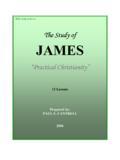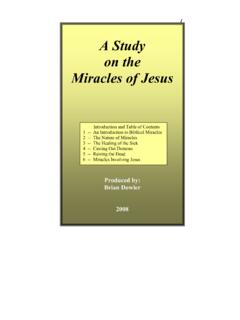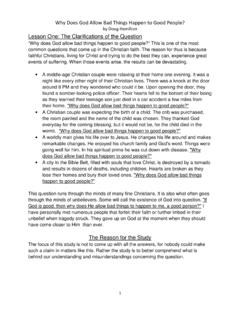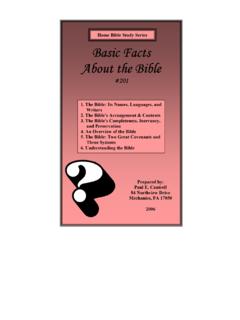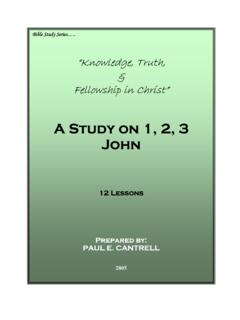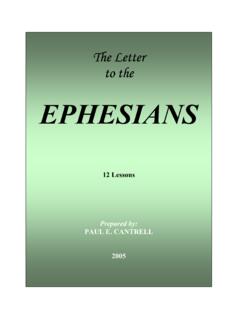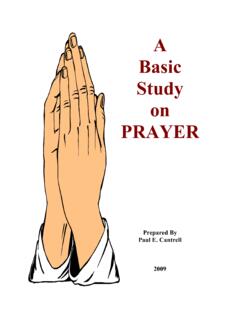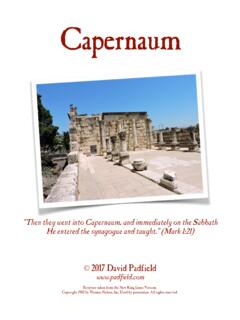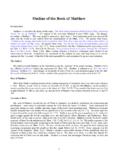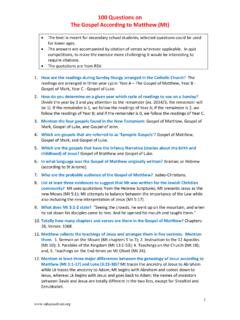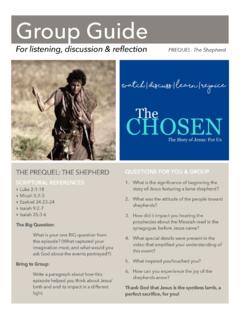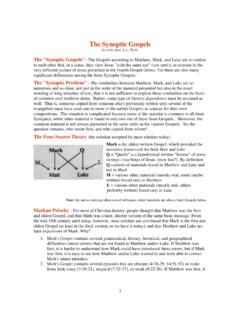Transcription of The Parables of Jesus - Camp Hill church
1 F The Parables of Jesus The Camp Hill church of Christ 3042 Cumberland Blvd. Camp Hill, PA 17011 1-717-737-5587 2 Introduction The Parables of Jesus are among the most beloved of all stories in the Bible, or ever told. Unique in approach, these simple and colorful stories were effective, because they played to the everyday experiences of people, with poignant endings that brought the message home powerfully. Jesus ' Parables were often surprising and paradoxical. Someone once said that listening to Jesus tell a parable must have been a little like watching someone throw a ball into the air. Instead of reaching its apex and returning directly to earth, this particular ball starts back down and then veers off at a right angle. We watch astonished, and search for answers. Today, a detailed study of the Parables can benefit us as well, as we search for our own answers. It is my intention to organize the material into a traditional 13 week format.
2 However, there is much more than can be covered in this time period. There are over 40 Parables and parabolic sayings covered in this outline, and that is not exhaustive. I encourage students of the Gospel to study the Parables in depth on their own time. This is simply a study tool let God s word be your guide. Acknowledgements I wish to thank Brother Paul Cantrell for suggesting the approach for categorizing the Parables , and for encouraging me to compile this study guide. Many thoughts were gleaned from The Parables Understanding the Stories Jesus Told by Simon J. Kistemaker. As much of the material is from this source, I have not made specific references. Please consider this book as referenced for much of this study. As with any source other than the Bible, I urge caution, as I disagree with the author on some points. Other sources were used as well, sometimes verbatim this work is as much a compilation of material from several sources, for the purpose of my own studies and teaching as such, I do not consider this an original work.
3 Cover Image Feeding the Multitude by William Hole. From The Life of Jesus of Nazareth. Eighty Pictures. Public domain - copyright expired. All images used are believed to be public domain. Compiled by Brian L. Dowler 3 Table of Contents 1) Introduction to the Parables .. 5 Types of Parables .. 5 The Composition of the Parables .. 6 The Purpose of the 6 Interpretation of the Parables .. 6 2) The Great Value of the Kingdom .. 9 Parable of the Hidden Treasure (Matt 13:44) .. 9 Parable of the Pearl of Great Price (Matt 13:45-46).. 9 Parable of the Great Feast (Luke 14:15-24).. 11 Parable of the Wedding Feast (Matt 22:1-14).. 13 3) The Cost of Citizenship of the Kingdom (1) .. 16 Parable of the Lost Sheep (Luke 15:1-7; Matt 18:12-14) .. 16 Parable of the Lost Coin (Luke 15:8-10) .. 17 Parable of the Prodigal Son (Luke 15:11-32) .. 19 4) The Cost of Citizenship in the Kingdom (2) .. 23 Parable of the Seed Growing Secretly (Mark 4:26-29).
4 23 Parable of a Tower Builder and King Going Forth to Battle (Luke 14:28-33).. 24 Parable of a Rich Fool (Luke 12:13-21) .. 26 Parable of the Empty House (Luke 11:24-26; Matt 12:43-45) ..28 5) Growth and Effectiveness of the Kingdom .. 31 Parable of the Mustard Seed (Matt 13:31; Mark 4:30-32; Luke 13:18-19) .. 31 Parable of the Yeast (Matt 13:33; Luke 13:20-21) .. 33 Parable of the Strong One Defeated (Luke 11:21-23; Matt 12:29) .. 34 Parable of the Barren Fruit Tree (Luke 13:6-9) .. 36 6) Ungodliness in the Kingdom .. 38 Parable of the Weeds (Matt 13:24-30, 36-43) .. 38 Parable of the Drag-Net (Matt 13:47-50).. 40 Parable of the Talents (Matt 25:14-30) .. 42 Parable of the Pounds (Luke 19:11-27) .. 45 7) Duties in the Kingdom (1) .. 49 Parable of the Householder (Matt 13:52).. 49 Parable of the Soils (Sower) (Matt 13:1-9, 18-23; Mark 4:1-9, 13-20; Luke 8:4-8, 11-15). 50 Parable of the Great Feast (Luke 14:7-14).. 53 Parable of the Barren Fig Tree (Luke 13:6-9).
5 56 8) Duties in the Kingdom (2) .. 59 Parable of the Pharisee and the Tax Collector (Luke 18:9-14).. 59 Parable of the Two Sons (Matt 21:28-32).. 62 Parable of the Tenants (Matt 21:33-45) .. 63 Parable of the Rich Fool (Luke 12:16-21) .. 66 9) Duties in the Kingdom (3) .. 70 Parable of the Unmerciful Servant (Matt 18:23-45) .. 70 Parable of the Friend at Midnight (Luke 11:5-8).. 73 Parable of the Widow and the Judge (Luke 18:1-8) .. 75 10) Duties in the Kingdom (4) .. 78 4 Parable of the Good Samaritan (Luke 10:30-37) .. 78 Parable of the Laborers in the Vineyard (Matt 20:1-16).. 82 Parable of the Unfaithful Steward (Luke 16:1-12) .. 86 11) The Need to be Ready for the Return of the King (1) .. 90 Parable of the Household Servants (Luke 12:35-40; Mark 13:32-37).. 90 Parable of the Servant with Authority (Matt 24:45-51; Luke 12:41-48) .. 92 Parable of the Master of the House (Matt 24:45-51; Luke 12:41-46) .. 94 12) The Need to be Ready for the Return of the King (2).
6 96 Parable of the Ten Virgins (Matt 15:1-13) .. 96 Parable of the Sheep and Goats (Matt 25:31-46).. 100 Parable of the Rich Man and Lazarus (Luke 16:19-31).. 103 13) Other Parables and Parabolic Sayings .. 107 Salt and Light (Matt 5:13-16; Mark 9:50; Luke 14:34-35) .. 107 Two Builders (Matt 7:24-27; Luke 6:47-48) .. 110 Children in the Marketplace (Matt 11:16-19; Luke 7:31-35) ..112 Parable of the Burglar (Matt 24:42-44; Luke 12:39-40).. 114 Parable of the Farmer and Servant (Luke 17:7-10) .. 116 Points to Ponder .. 118 5 1) Introduction to the Parables In his Parables , Jesus drew interesting verbal word pictures of the world around his listeners. These colorful stories, taken from everyday life, were used to teach simple yet powerful lessons. In his Parables , the emphasis is usually placed at the end of the story making a strong conclusion that led the listener to accept the message. The messages were so plain, and so simple, that only the most hardened could refuse or reject the teaching.
7 In The Parables of the Kingdom C. H. Dodd wrote that a parable "leaves the mind in sufficient doubt about its precise application to tease it into active thought." Parables often have more in common with probing, uncompromising, puzzling questions than they do with answers. There is some disagreement on the exact number of stories to be characterized as Parables . Of the four canonical gospels the Parables are almost all in the three synoptic gospels. According to one count, The Gospel of Luke contains both the largest total number of Parables (24) and the largest number of unique Parables found nowhere else (10); The Gospel of Matthew contains 23 Parables of which six are unique; The Gospel of Mark contains eight Parables of which only one (the Parable of the Growing Seed, Mark 4:26-29) is unique. John does not contain any Parables ; rather it contains metaphoric stories or allegories, such as The Shepherd (John 10:1-21) and The Vine (John 15:1-17) which some scholars argue is a parable, to much disagreement.
8 Although Jesus was not the first teacher to use Parables , the number of Parables and the impact of his parabolic teachings was without precedent. A famous and quite ancient Old Testament example is the parable of the ewe lamb which the prophet Nathan addressed to David. After the king had arranged the death of Bathsheba's husband on the battlefield so that he might himself marry Bathsheba, Nathan told him a story about a man who killed another man s ewe in (2 Sam 12:1-4) When David condemned the man as deserving to die, Nathan revealed that the story was a parable, saying, "You are the man" ( ). Types of Parables 1) True Parables Stories based on true, visible scenes and events. For example, seeds growing, yeast at work, losing a Self evident truths . 2) Story Parables Do not rely on obvious truths but instead are based upon experiences . For example, the Parable of the tares, the rich man and Lazarus, etc. 3) Illustrations Exhibit behaviors to be copied or avoided.
9 For example, the Rich Fool, the Good Samaritan. 4) Parabolic Sayings Short statements, such as; Jesus teachings on Salt and Light, Physician heal thyself , No one sews a new patch on an old garment , No one puts new wine in an old wineskin , A pupil is not above his teacher and Can a blind man lead a blind man? Many of these can be found in Luke chapters 4-7. Many Parables show traits of two of the above characteristics not all can be neatly boxed into one category. 6 According to , A parable is a brief, succinct story, in prose or verse that illustrates a moral or religious lesson. It differs from a fable in that fables use animals, plants, inanimate objects, and forces of nature as characters, while Parables generally feature human A parable is one of the simplest of narratives. It sketches a setting, describes an action, and shows the results. It often involves a character facing a moral dilemma, or making a questionable decision and then suffering the consequences.
10 As with a fable, a parable generally relates a single, simple, consistent action, without extraneous detail or distracting circumstances. The Composition of the Parables Most Parables should be interpreted as teaching a single, simple lesson. Many scholars make the mistake of trying to read too much into the Parables . This usually leads to stretching the teaching such that it conveys more than what Jesus intended. This type of interpretation reached it s apex in the Middle Ages. But today most modern scholars agree that a master teacher such as Jesus knows that a singe point, taught clearly, is better than many points forgotten. There are some Parables , however, that teach multiple lessons by design such as the parable of the sower, which teaches about four different ways that the Word of God is received. Jesus often uses the literary device of Triads three primary characters or main illustrative keys. For example: o The Friend at Midnight The traveler, the friend, the neighbor o The Prodigal Son The father, the son, the brother o The Parable of the Virgins The bridegroom, the wise virgins, the foolish virgins In Jesus Parables , the end is nearly always more important than the beginning.
